
Community based resources
management and CCA
Stulwane-Costoneand Ezibomvini: Bergville September 2023

Our Vision
•Tosupporttheharmoniouslivingofpeopleintheirnatural,
social and economic environments in a way that supports
and strengthens both the people and their environment.
•Toassisttheruralpoortobettertheirlives,todiversifytheir
livelihoods and to face their challenges with resilience.
Our Mission
•Todesignandimplementinnovativeprojectsand
programmes which promote collaborative, pro-poor
agricultural innovation, working in partnership with other
organizations and communities.
•Toworkatthecuttingedgeofdevelopmentmethodology
and process integrating learning (training), research and
implementation into new models and processes emphasizing
synergy and integration.
Promoting collaborative, pro-poor agricultural
innovation
2003-2023

CRA
learning
group
VSLAs
Marketing
committees
Water
committees
Livestock
associations
Youth
groups
CCA impact
assessments
Adaptive
strategies and
planning
Innovation and
practices
Implementation
Monitoring,
cyclical review
and evalution
Government
departments
Traditionalauthority
Ward committees
Local Municipality
Business
community
Academia
Civil
Society
Innovation
platforms –
clusters of LGs
Associations and
organisations
Multistakeholder
platforms
CRA learning groups: Process for development of social agency

Participatory
Innovation
Development
A summaryoftheInnovation
steps
•Getting started (getting to know
each other);
•Joint analysis of the situation –
the problems and opportunities;
•Looking for things to try to
improve the local situation;
•Trying them out in community-led
participatory experimentation;
•Jointly analysis and sharing the
results; and
•Strengthening the process, often
through improving local
organization and linkages with
other actors, so that the innovation
process will continue.
Farmer led innovation builds on
the PID concepts to include local
innovations into the system and
describes the interaction between
local communities and outside
facilitators, as:
•Gaining a joint understanding of
the main characteristics and
changes of that particular
agroecological system,
•Defining priority problems,
•Experimenting locally with a
variety of options derived both
from indigenous knowledge … and
from formal science and
•Enhancing farmer’s experimental
capacities and farmer-to-farmer
communication
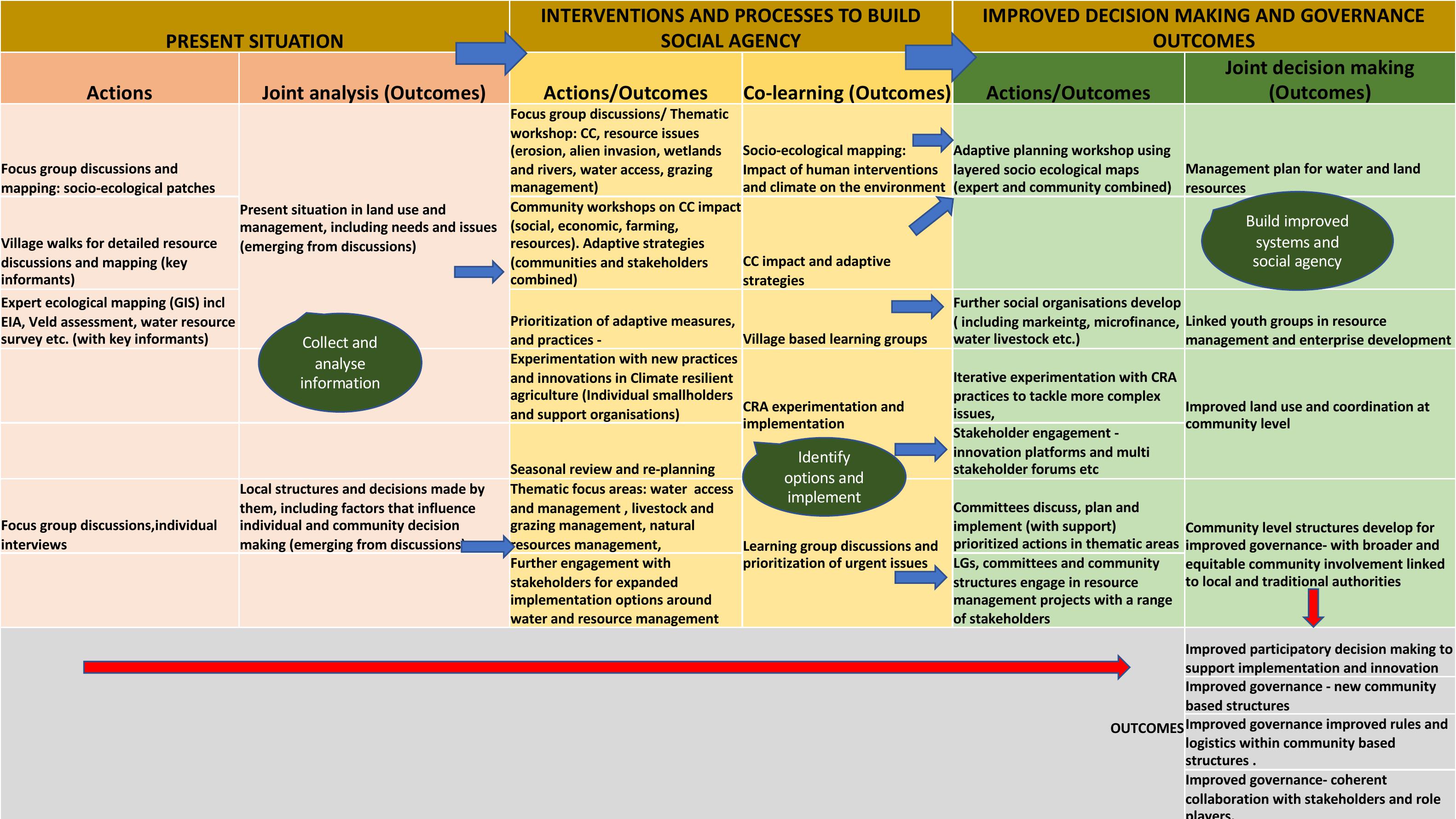
PRESENT SITUATION
INTERVENTIONS AND PROCESSES TO BUILD
SOCIAL AGENCY
IMPROVED DECISION MAKING AND GOVERNANCE
OUTCOMES
Actions Joint analysis (Outcomes)Actions/Outcomes
Co
-
learning (Outcomes)
Actions/Outcomes
Joint decision making
(Outcomes)
Focus group discussions and
mapping: socio
-ecological patches
Present situation in land use and
management, including needs and issues
(emerging from discussions)
Focus group discussions/ Thematic
workshop: CC, resource issues
(erosion, alien invasion, wetlands
and rivers, water access, grazing
management)
Socio
-ecological mapping:
Impact of human interventions
and climate on the environment
Adaptive planning workshop using
layered socio ecological maps
(expert and community combined)
Management plan for water and land
resources
Village walks for detailed resource
discussions and mapping (key
informants)
Community workshops on CC impact
(social, economic, farming,
resources). Adaptive strategies
(communities and stakeholders
combined)
CC impact and adaptive
strategies
Expert ecological mapping (GIS)
incl
EIA, Veld assessment, water resource
survey etc. (with key informants)
Prioritization of adaptive measures,
and practices
-
Village based learning groups
Further social organisations develop
( including markeintg, microfinance,
water livestock etc.)
Linked youth groups in resource
management and enterprise development
Experimentation with new practices
and innovations in Climate resilient
agriculture (Individual smallholders
and support organisations)
CRA experimentation and
implementation
Iterative experimentation with CRA
practices to tackle more complex
issues,
Improved land use and coordination at
community level
Seasonal review and re
-planning
Stakeholder engagement
-
innovation platforms and multi
stakeholder forums etc
Focus group discussions,individual
interviews
Local structures and decisions made by
them, including factors that influence
individual and community decision
making (emerging from discussions)
Thematic focus areas: water access
and management , livestock and
grazing management, natural
resources management,
Learning group discussions and
prioritization of urgent issues
Committees discuss, plan and
implement (with support)
prioritized actions in thematic areas
Community level structures develop for
improved governance
- with broader and
equitable community involvement linked
to local and traditional authorities
Further engagement with
stakeholders for expanded
implementation options around
water and resource management
LGs, committees and community
structures engage in resource
management projects with a range
of stakeholders
OUTCOMES
Improved participatory decision making to
support implementation and innovation
Improved governance
- new community
based structures
Improved governance improved rules and
logistics within community based
structures .
Improved governance
- coherent
collaboration with stakeholders and role
players.
Collect and
analyse
information
Identify
options and
implement
Build improved
systems and
social agency
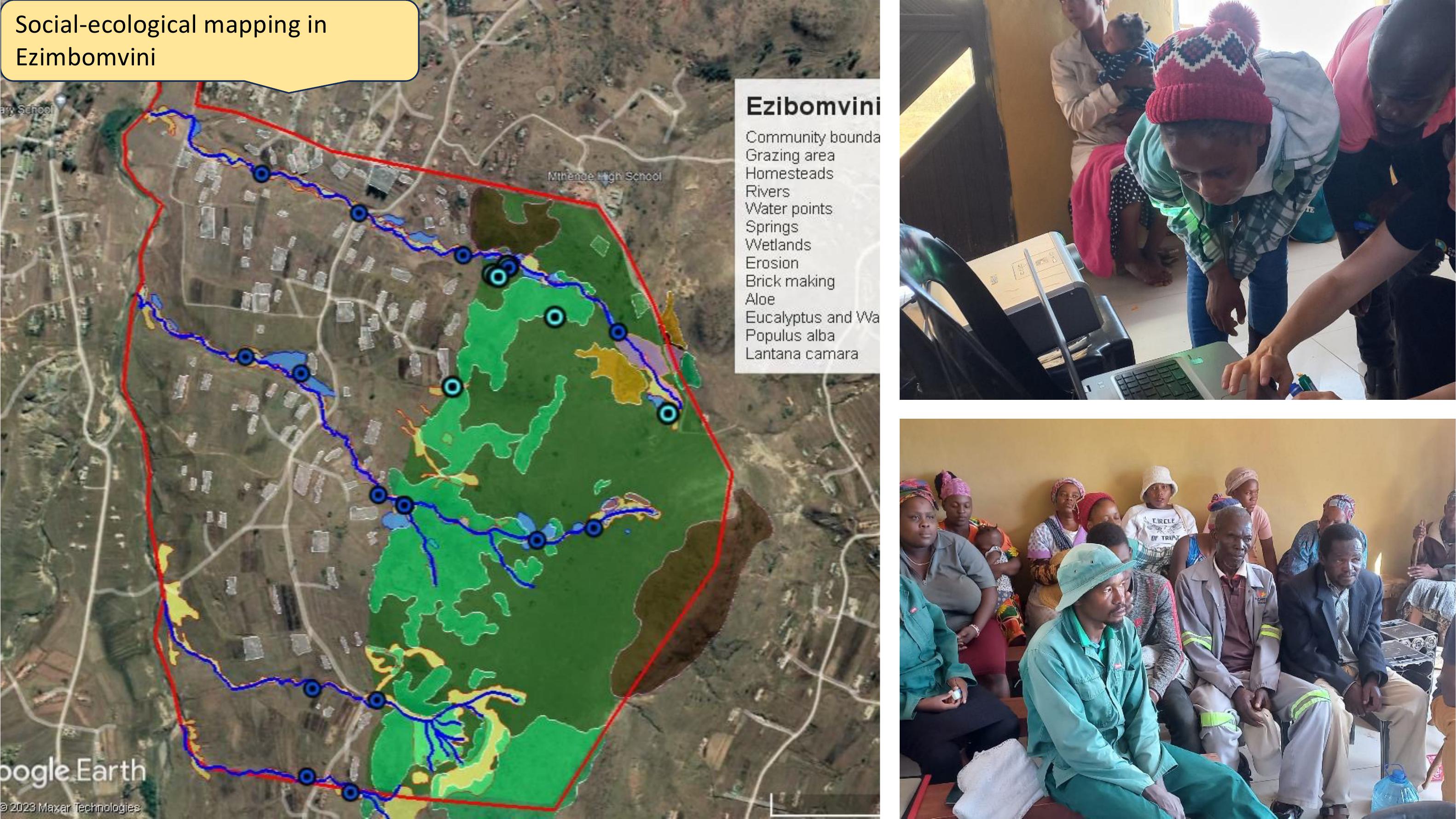
Social-ecological mapping in
Ezimbomvini
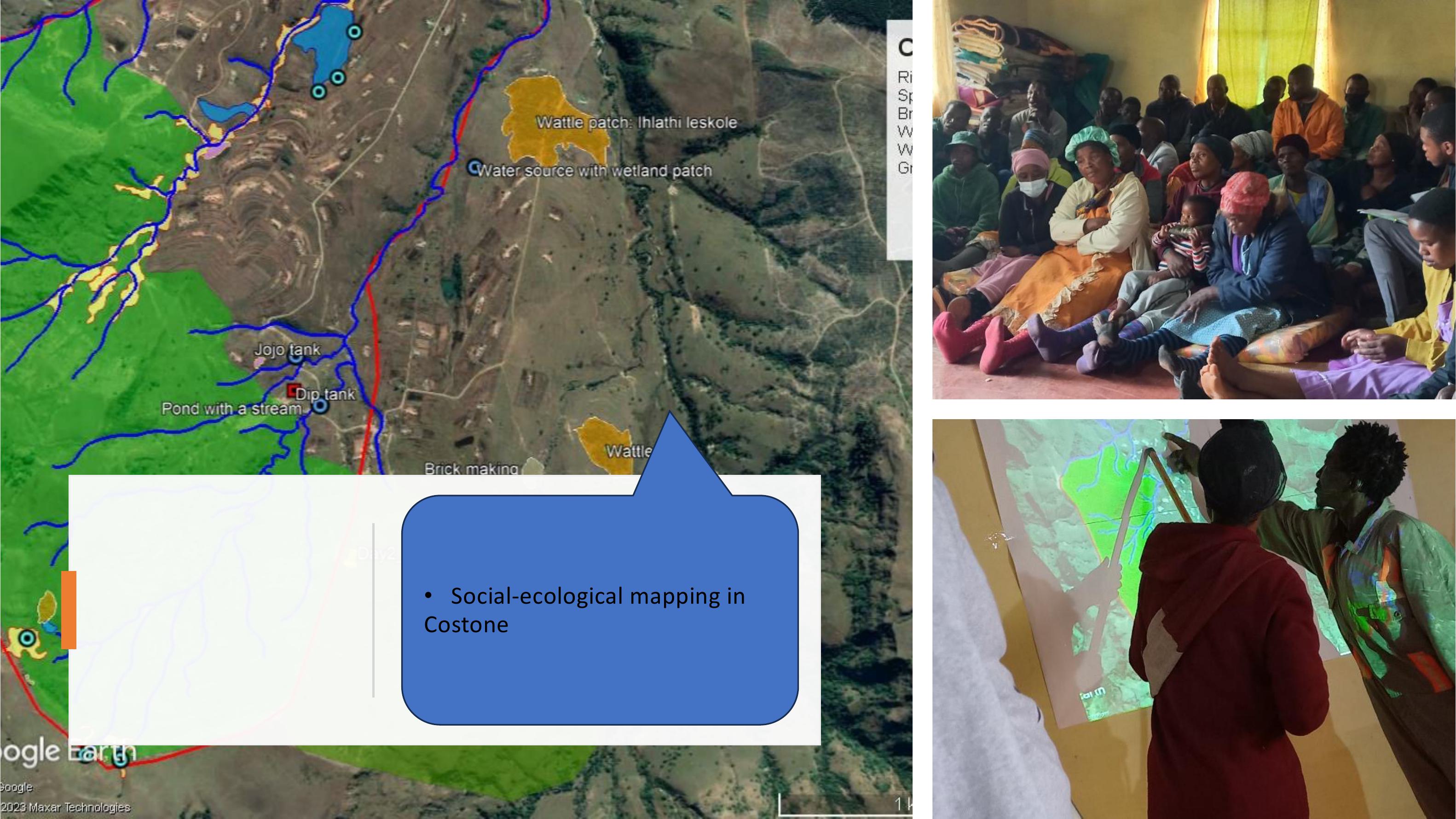
•Social-ecological mapping in
Costone

Local resource management areas for improved eco system services
- Community defined
Key Area
Management required
Notes
Grazing areas
(Amadlelo)
-
Livestock feed and water,
firewood, medicinal plants,
Restoration and management
.
-
Clear Lantana and use poison after cutting to stop regrowth
-
Rotational grazing
-
Control wildfires and make firebreaks. Storage drums for emergencies with fire one can
use
-
Explore financial benefit – grant/incentive mechanisms
-
Monitor and manage nutrition of veld (erosion control, overgrazing control, removal of
poisonous weeds, re
-seed of palatable species)
-
Awareness raising in the community and for livestock owners.
-
Eco-champs to do clearing
-
Dip tank committees and livestock associations
-
Better community collaboration with dip tank committee
as well as TA and councillors
-
Community workdays
- Clearing of Lantana in Ezibomviniand Costone.
- Moving gates and fixing fences in Costonegrazing
area
- Workshop presented by Working on Fire team in
the uThukela area- re firebreaks and fire
management
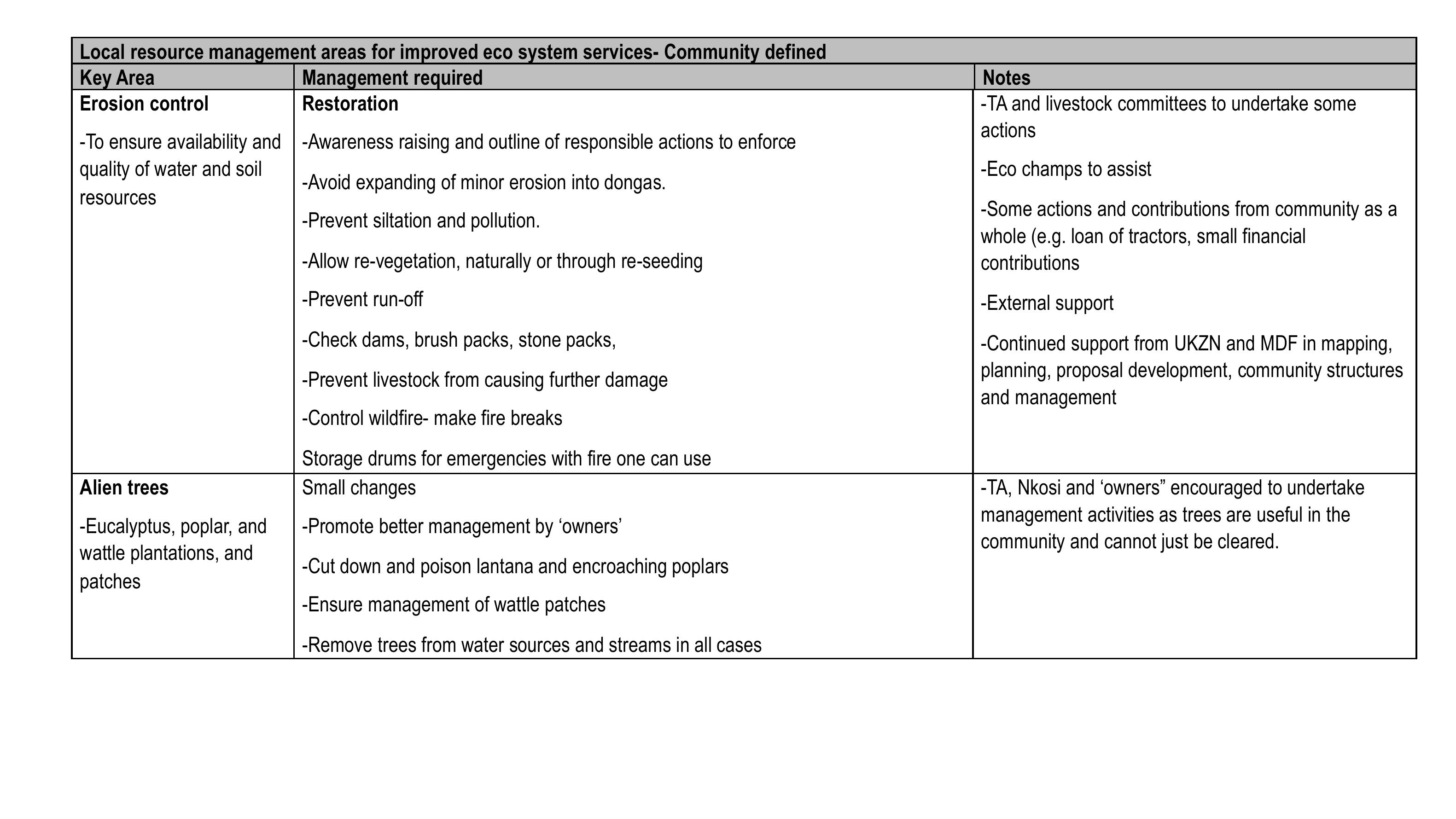
Erosion control
-Toensureavailabilityand
quality of water and soil
resources
Restoration
-
Awareness raising and outline of responsible actions to enforce
-
Avoid expanding of minor erosion into dongas.
-
Prevent siltation and pollution.
-
Allow re-vegetation, naturally or through re-seeding
-
Prevent run-off
-
Check dams, brush packs, stone packs,
-
Prevent livestock from causing further damage
-
Control wildfire- make fire breaks
Storage drums for emergencies with fire one can use
-
TA andlivestockcommitteestoundertakesome
actions
-
Eco champs to assist
-
Some actions and contributions from community as a
whole (e.g. loan of tractors, small financial
contributions
-
External support
-
Continued support from UKZN and MDF in mapping,
planning, proposal development, community structures
and management
Alien trees
-
Eucalyptus, poplar, and
wattle plantations, and
patches
Small changes
-
Promote better management by ‘owners’
-
Cut down and poison lantana and encroaching poplars
-
Ensure management of wattle patches
-
Remove trees from water sources and streams in all cases
-
TA,Nkosiand‘owners”encouragedtoundertake
management activities as trees are useful in the
community and cannot just be cleared.
Local resource management areas for improved eco system services
- Community defined
Key Area
Management required
Notes
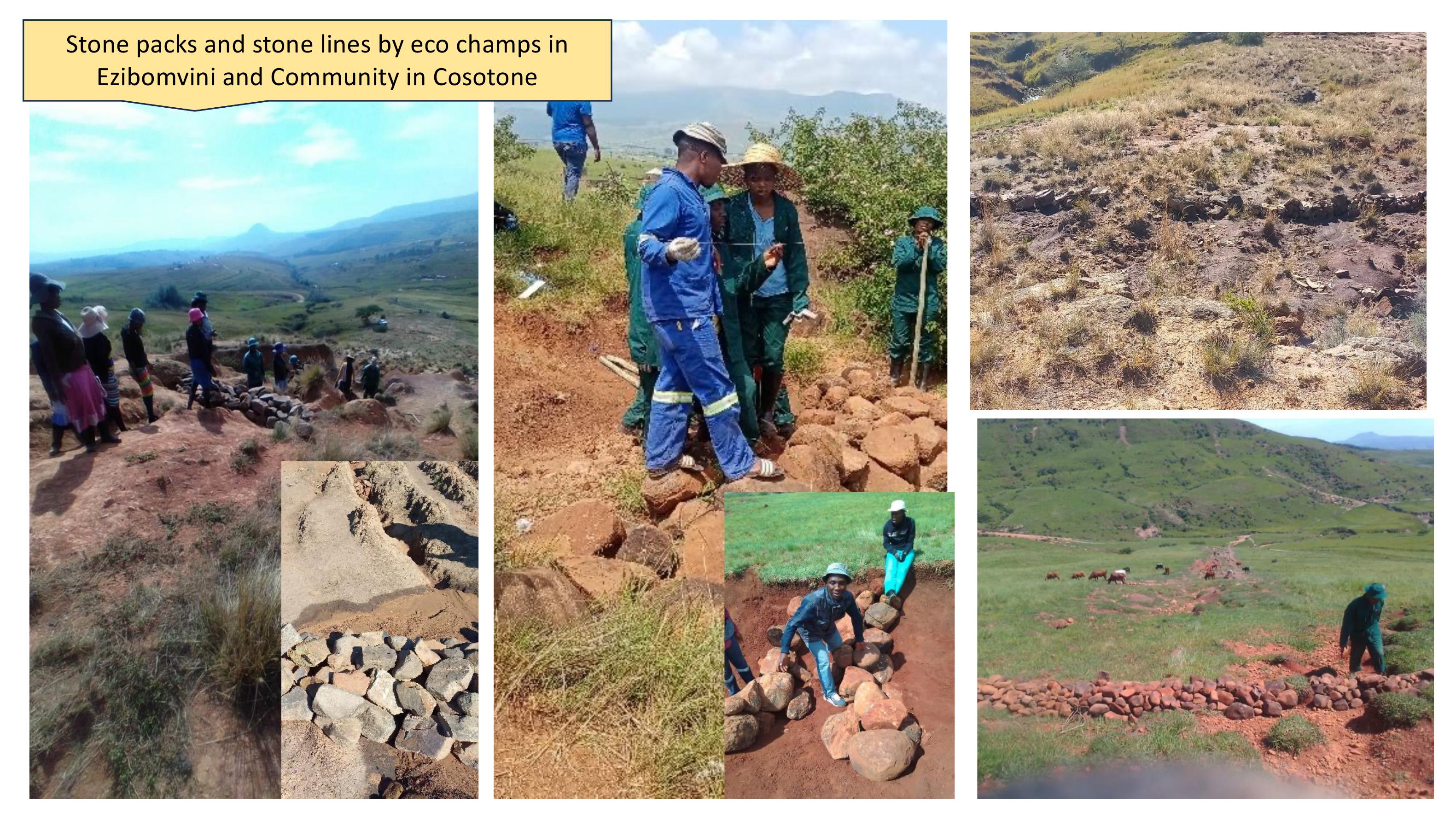
Stone packs and stone lines by eco champs in
Ezibomviniand Community in Cosotone

Community based clearing of wattle in Costone
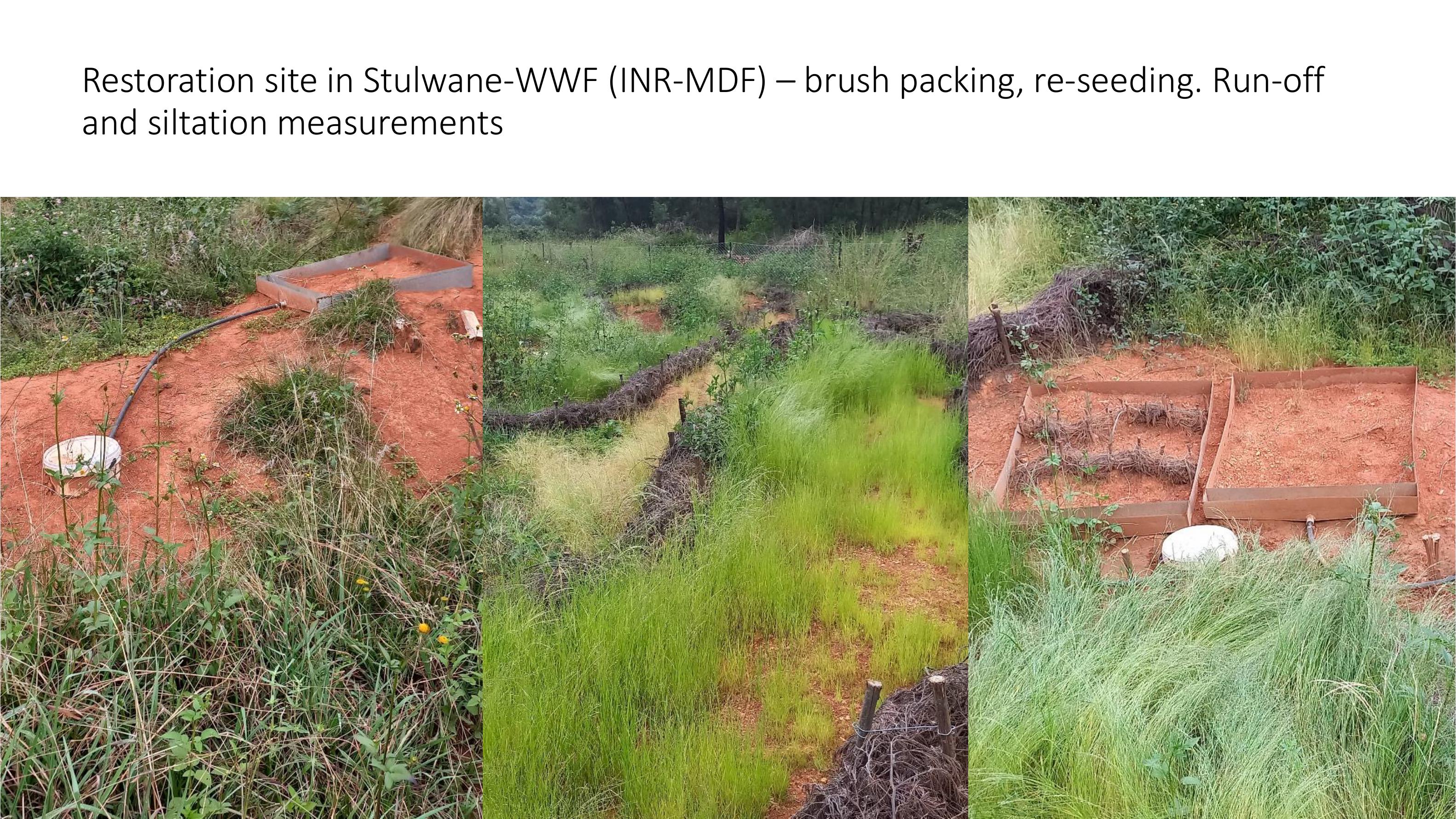
RestorationsiteinStulwane-WWF (INR-MDF) – brush packing, re-seeding. Run-off
and siltation measurements
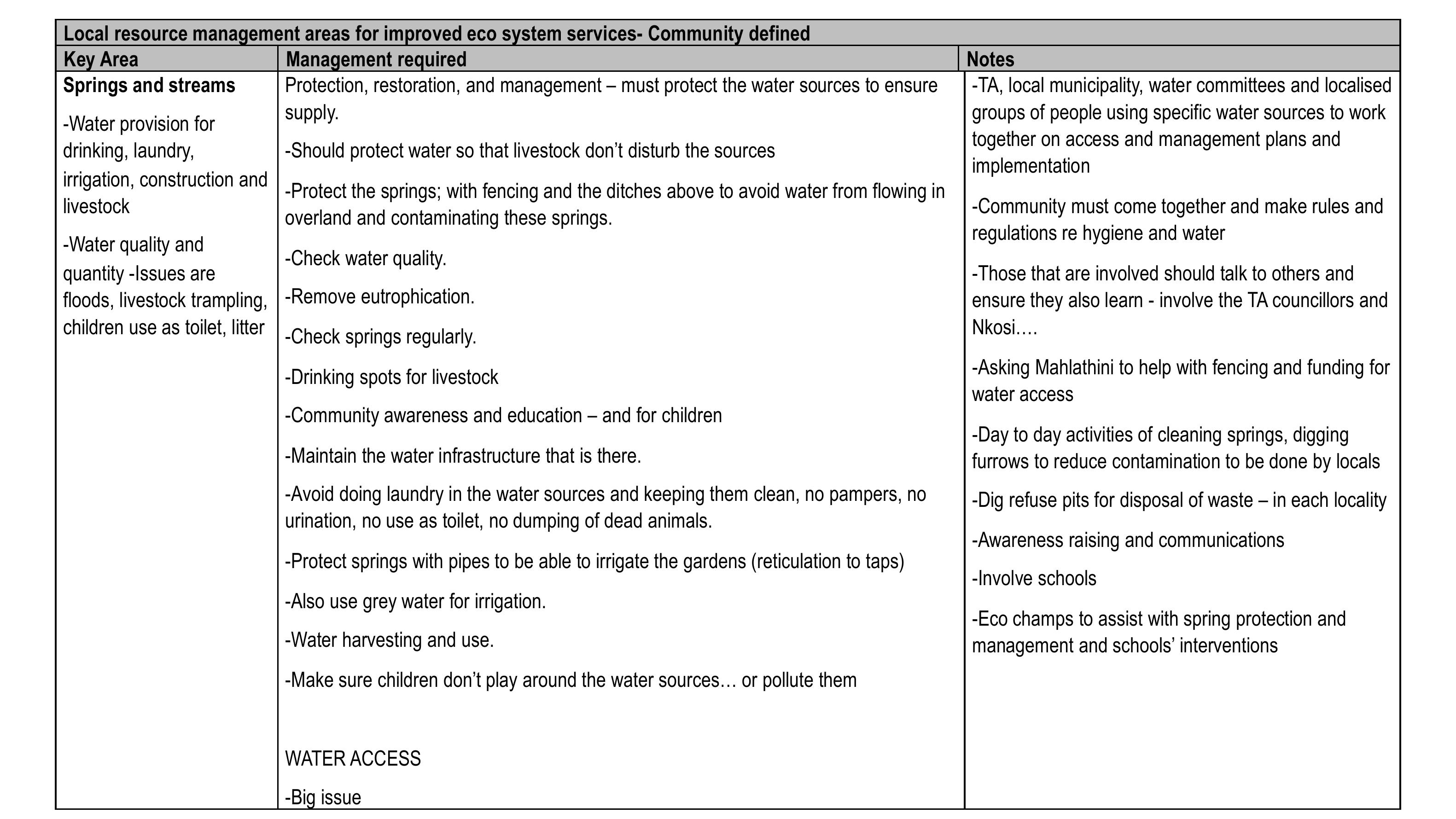
Springs and streams
-
Waterprovisionfor
drinking, laundry,
irrigation, construction and
livestock
-
Waterquality and
quantity
-Issues are
floods, livestock trampling,
children use as toilet, litter
Protection, restoration, and management
– must protect the water sources to ensure
supply.
-
Should protect water so that livestock don’t disturb the sources
-
Protect the springs; with fencing and the ditches above to avoid water from flowing in
overland and contaminating these springs.
-
Check water quality.
-
Remove eutrophication.
-
Check springs regularly.
-
Drinking spots for livestock
-
Community awareness and education – and for children
-
Maintain the water infrastructure that is there.
-
Avoid doing laundry in the water sources and keeping them clean, no pampers, no
urination, no use as toilet, no dumping of dead animals.
-
Protect springs with pipes to be able to irrigate the gardens (reticulation to taps)
-
Also use grey water for irrigation.
-
Waterharvestinganduse.
-
Make sure children don’t play around the water sources… or pollute them
WATER ACCESS
-
Big issue
-TA,localmunicipality,watercommitteesandlocalised
groups of people using specific water sources to work
together on access and management plans and
implementation
-Community must come together and make rules and
regulations re hygiene and water
-
Those that are involved should talk to others and
ensure they also learn
-
involve the TA councillors and
Nkosi….
-
Asking Mahlathini
to help with fencing and funding for
water access
-
Day to day activities of cleaning springs, digging
furrows to reduce contamination to be done by locals
-
Dig refuse pits for disposal of waste – in each locality
-
Awareness raising and communications
-
Involve schools
-
Eco champs to assist with spring protection and
management and schools’ interventions
Local resource management areas for improved eco system services
- Community defined
Key Area
Management required
Notes
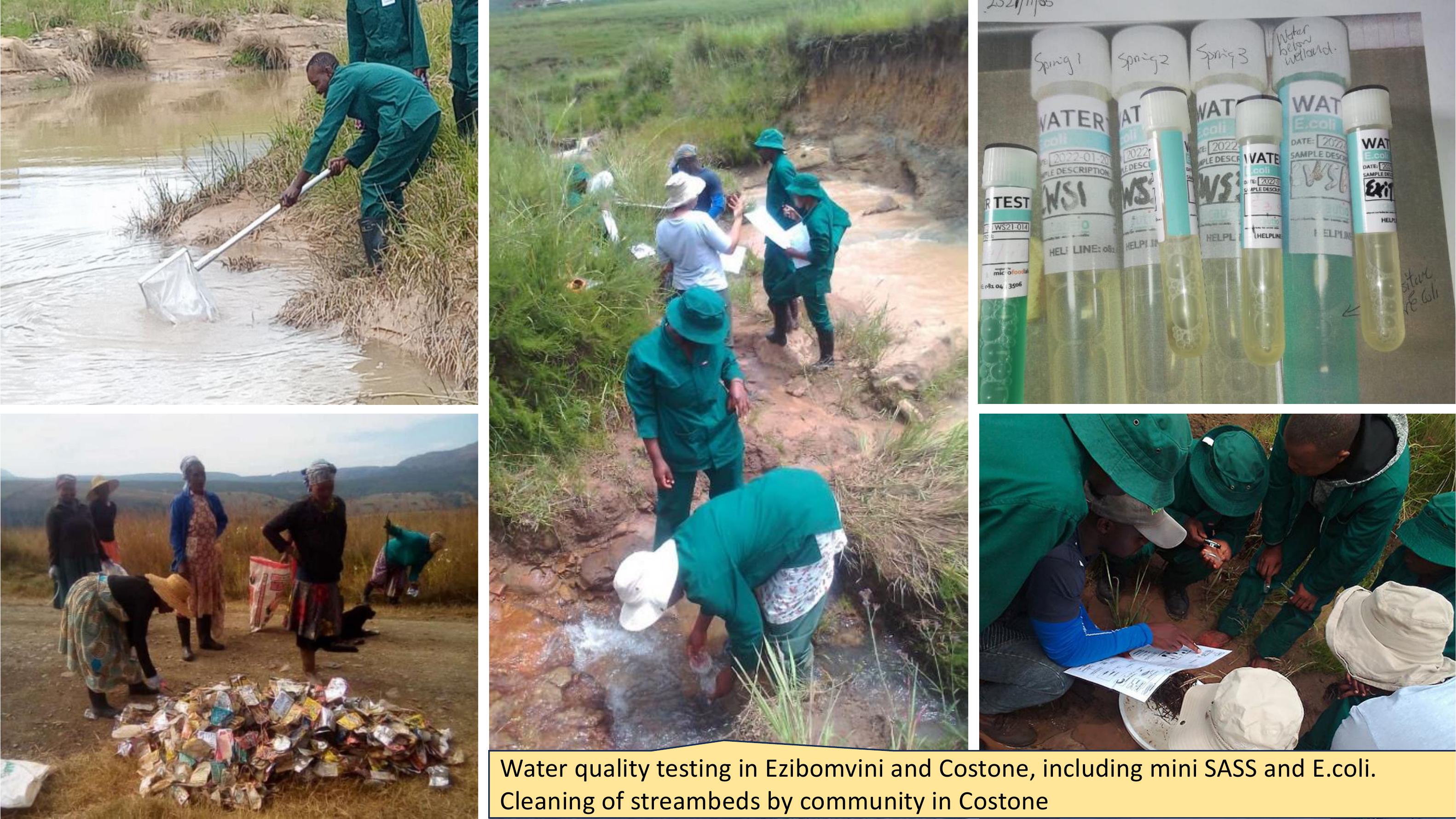
WaterqualitytestinginEzibomviniand Costone, including mini SASS and E.coli.
Cleaning of streambeds by community in Costone

Spring protection and reticulation in Costone:Community and
eco-champs

Planning stream abstraction for multi purpose water supply – Costone – July-Sept 2023

Wetlands
(Amacaphuza),
-
Reeds (incema)
-Food and water for cattle,
also in winter
-
Medicinal plants
-
Fire retardant
-
Runoff and flood water
management
-
Improved water quality
-
Fertile soils with
earthworms
Small management changes to manage condition of wetlands.
-
Fencing to ensure good condition and make drinking troughs for livestock
-
Awareness raising on wetlands functions and services
-
Replanting important species into wetlands; then someone needs to police this and
ensure people don’t just harvest everything
-
Protection and restoration of important medicinal species for sale: Stop people with
big bags who come in and take for selling
-
Avoid pigs coming in as they mess things up
-
Avoid fires and burning
-
Livestock inclusion managed e.g. –allow them in at certain times only. Or maybe
make camps and move them. Or allow them to graze on the edges. Or cut and carry
feed.
-
TA involvementand‘landowners’inwetlandareasto
outline rules and responsibilities
-
Community as a whole to follow these
-
Local water and land use committees to undertake
specific actions related to water access and
management
-
Issues around rights around use of water and
important medicinal plants need further interventions
-
Suggestion: talk to livestock association then bring
their comments and suggestions to the water
committee to continue the conversation and include all
Local resource management areas for improved eco system services
- Community defined
Key Area
Management required
Notes
No interventions as yet around wetlands – requires whole
community commitment as well as intervention by traditional
authorities for changing rules of use and management

Conservation Agriculture


Livestock integration – Grazing, supplementation, management
- Grazing cover crops or stover in situ
- Collection of stover for baling and grazing and
- Cutting of veld grass for baling and stover
- Use of bales with winter fodder supplements, e.g. LS 33, premix450
- Return of manure to the fields (carry or in situ)
- Multipurpose chickens
- Broilers and layers (systems and management)
-Small scale piggeries
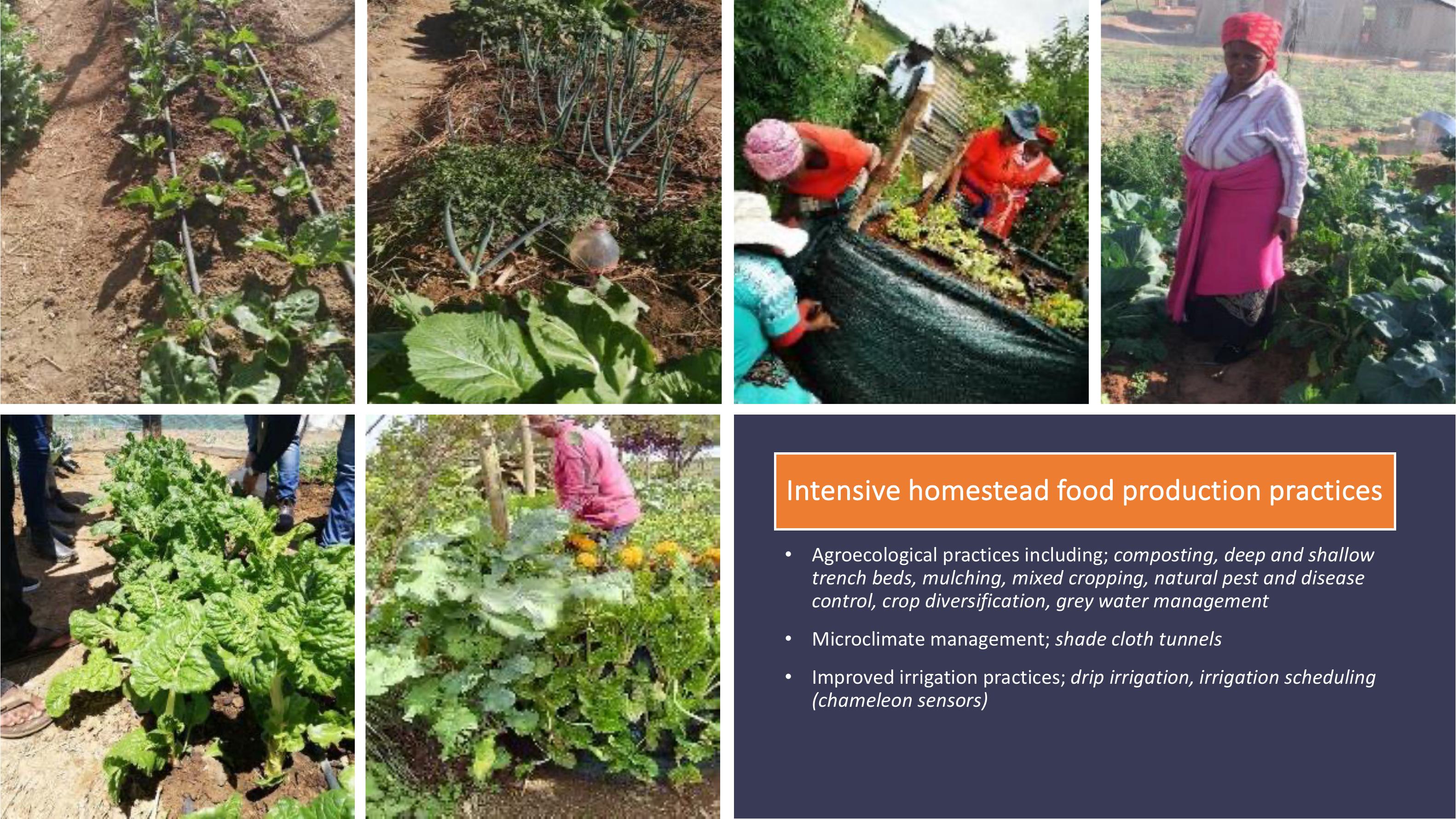
Intensive homestead food production practices
•Agroecological practices including; composting, deep and shallow
trench beds, mulching, mixed cropping, natural pest and disease
control, crop diversification, grey water management
•Microclimate management;shade cloth tunnels
•Improved irrigation practices; drip irrigation, irrigation scheduling
(chameleon sensors)

Local
marketing
•Doubled production and
incomes in just over 2 years.
•Income potential of R1000-
R3000/month

Thank you